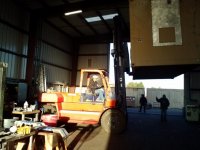Always want to be on my A game so, I will ask.
So. For those Certified Forklift Operators, be it a sit-down, stand up, or even a reach truck. My question is about the proper thing to do when you first have your forks all the way in to the pallet.
Should you use your tilt, and tilt back first, then lift up, or.. should you do it the other way, lift up slightly and then tilt back, before going backwards with your fork to clear the rack?
I see operators do both ways. When I worked with coffee, 4000lbs pallets.. they told me, you should lift up first, then tilt back to stabilize the weight. Those were heavy pallets. Then, at another warehouse, I've seen them tilt back first, then come back off the rack.
I think I would slightly prefer to come up before tilting, so that the forks are flat under the pallet, may not even need to sue tilt at all, unless the company likes to see that ? Could make the case it is not necessary on a light pallet.
Let the discussion begin. Also, any other tips and tricks.. I am past the point where I am smooth with the forks (usually Crown) and now I want to really build up confidence.
So. For those Certified Forklift Operators, be it a sit-down, stand up, or even a reach truck. My question is about the proper thing to do when you first have your forks all the way in to the pallet.
Should you use your tilt, and tilt back first, then lift up, or.. should you do it the other way, lift up slightly and then tilt back, before going backwards with your fork to clear the rack?
I see operators do both ways. When I worked with coffee, 4000lbs pallets.. they told me, you should lift up first, then tilt back to stabilize the weight. Those were heavy pallets. Then, at another warehouse, I've seen them tilt back first, then come back off the rack.
I think I would slightly prefer to come up before tilting, so that the forks are flat under the pallet, may not even need to sue tilt at all, unless the company likes to see that ? Could make the case it is not necessary on a light pallet.
Let the discussion begin. Also, any other tips and tricks.. I am past the point where I am smooth with the forks (usually Crown) and now I want to really build up confidence.


